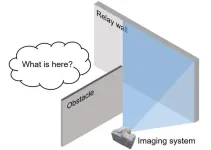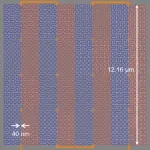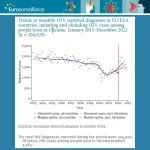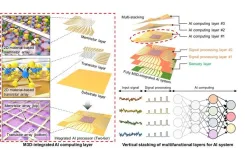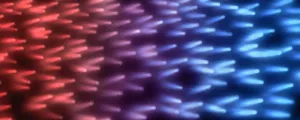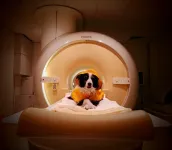(Press-News.org) WASHINGTON — Emerging technologies for non-line-of-sight imaging can detect objects even if they are around a corner or behind a wall. In new work, researchers use a new type of detector to extend this method from visible light into near and mid-infrared wavelengths, an advance that could be especially useful for unmanned vehicles, robotic vision, endoscopy and other applications.
“Infrared non-line-of-sight imaging can improve the safety and efficiency of unmanned vehicles by helping them detect and navigate around obstacles that are not directly visible,” said Xiaolong Hu from Tianjin University in China. His team collaborated with a group led by Jingyu Yang, also from Tianjin University. “Using near-infrared wavelengths could also help reduce eye safety concerns and lower the background noise, which could potentially allow imaging over longer distances during daytime.”
In the Optica Publishing Group journal Optics Express, the researchers describe the first demonstration of non-line-of-sight imaging using an advanced light-sensing component known as a superconducting nanowire single-photon detector. This detector exhibits single-photon sensitivity from x-ray to the mid-IR wavelengths, enabling researchers to extend the imaging technique’s spectral range to the near and mid-infrared wavelengths of 1560 and 1997 nm. The researchers also developed a new algorithm to further improve the images obtained by the system.
“This proof-of-principle demonstration opens doors for more research opportunities and potential applications,” said Hu. “Moving non-line-of-sight imaging toward the mid-infrared wavelengths brings advantages for many applications. In addition to improving navigation for robots and vehicles, it could also enhance the signal-to-noise ratio for biological imaging.”
Creating a sensitive eye
Non-line-of-sight imaging technologies use photodetectors to detect multiple rays of reflected light emitted or reflected from objects outside the line of sight. Unlike traditional line-of-sight imaging techniques such as LiDAR and photography, the light detected for non-line-of-sight imaging is very faint. This requires very high sensitivity detectors.
“We designed and made a superconducting nanowire single-photon detector that acts as a very sensitive eye for seeing an object hidden around a corner,” said Hu. “This detector outperforms other single-photon detectors in terms of detection efficiency in the near and mid-infrared spectral ranges, which made it possible to perform non-line-of-sight imaging at longer wavelengths.”
Superconducting nanowire single-photon detectors are based on the fact that a single photon will disrupt superconductivity. This creates a measurable change in electrical resistance that allows the detection of individual photons with high efficiency. In the new work, the researchers created a single-photon detector with 40-nm-wide nanowires arranged in a fractal pattern. This pattern, which exhibits similar shapes at various magnifications, makes it possible to effectively detect photons in all polarizations. The detector was cooled to ~2 K (just above absolute zero), which is required to achieve superconductivity.
Imaging in the infrared
After demonstrating that their superconducting nanowire single-photon detector exhibited better timing resolution and lower noise than an InGaAs/InP single-photon avalanche diode, the researchers used the new detector to acquire non-line-of-sight imaging at both 1560 and 1997 nm. They were able to achieve a spatial resolution of less than 2 cm for both wavelengths. They also showed that images reconstructed using their new algorithm had a significantly lower root mean square error — a measure of the deviation from the ideal image — than those reconstructed using other methods.
The researchers are now working to extend their work by exploring other wavelengths of interest and examining how arranging multiple superconducting nanowire single-photon detectors into arrays might enable additional capabilities. They also want to experiment with using their new system to achieve non-line-of-sight imaging over longer distances during the day.
Paper: Y. Feng, X. Cui, Y. Meng, X. Yin, K. Zou, Z. Hao, J. Yang, X. Hu, “Non-line-of-sight imaging at infrared wavelengths using a superconducting nanowire single-photon detector,” Opt. Express, Vol. 31, Issue 25, pp. 42240-42254 (2023). doi.org/10.1364/OE.497802
About Optics Express
Optics Express reports on scientific and technology innovations in all aspects of optics and photonics. The bi-weekly journal provides rapid publication of original, peer-reviewed papers. It is published by Optica Publishing Group and led by Editor-in-Chief James Leger of the University of Minnesota, USA. Optics Express is an open-access journal and is available at no cost to readers online. For more information, visit Optics Express.
About Optica Publishing Group (formerly OSA)
Optica Publishing Group is a division of Optica, the society advancing optics and photonics worldwide. It publishes the largest collection of peer-reviewed content in optics and photonics, including 18 prestigious journals, the society’s flagship member magazine, and papers from more than 835 conferences, including 6,500+ associated videos. With over 400,000 journal articles, conference papers and videos to search, discover and access, Optica Publishing Group represents the full range of research in the field from around the globe.
END
Researchers extend non-line-of-sight imaging towards longer wavelengths
New system uses superconducting nanowire single-photon detector; could be useful for self-driving vehicles, robotic vision and more
2023-11-30
ELSE PRESS RELEASES FROM THIS DATE:
EU/EEA: HIV diagnoses rise for the first time in a decade
2023-11-30
Across the 30 countries of the European Union and European Economic Area (EU/EEA), 22,995 new HIV diagnoses were reported in 2022. Almost every second new HIV diagnosis (49%, n=11,103) was among migrants, i.e. among people who were not born in in the country they were diagnosed in. born abroad from the country of their diagnosis.
In the aftermath of Russia’s invasion of Ukraine in 2022, more than 4 million Ukrainians took refuge in countries of the European Union and European Economic Area (EU/EEA). In a rapid communication published in Eurosurveillance prior to World AIDS Day 2023 on 1 December, Reyes-Urueña et al. look at most recent surveillance data ...
2D material reshapes 3D electronics for AI hardware
2023-11-30
Multifunctional computer chips have evolved to do more with integrated sensors, processors, memory and other specialized components. However, as chips have expanded, the time required to move information between functional components has also grown.
“Think of it like building a house,” said Sang-Hoon Bae, an assistant professor of mechanical engineering and materials science at the McKelvey School of Engineering at Washington University in St. Louis. “You build out laterally and up vertically to get more ...
George Demetri, MD, of Dana-Farber earns Lifetime Achievement Award in Medicine from Stanford University School of Medicine
2023-11-30
Boston – George Demetri, MD, director of the Sarcoma Center at Dana-Farber Cancer Institute, is being awarded the prestigious J.E. Wallace Sterling Lifetime Achievement Award in Medicine from the Stanford Medicine Alumni Association (SMAA). Demetri, an alumnus of the Stanford University School of Medicine, Class of 1983, will be honored at a dinner held on the Stanford University School of Medicine campus on December 4, 2023.
“Dr. Demetri is a leader in developing targeted therapeutics for cancer and has been pivotal in advancing oncology treatments ...
Snake skulls show how species adapt to prey
2023-11-30
By studying the skull shapes of dipsadine snakes, researchers at The University of Texas at Arlington have found how these species of snakes in Central and South America have evolved and adapted to meet the demands of their habitats and food sources.
The research, conducted in collaboration with colleagues at the University of Michigan, was published in the peer-reviewed journal BMC Ecology and Evolution.
“We now have evidence that this group of snakes is one of the most spectacular and largest vertebrate adaptive radiations currently known to science,” said Gregory Pandelis, collections manager at UTA’s Amphibian and Reptile Diversity ...
IU researchers develop new brain network modeling tools to advance Alzheimer's disease research
2023-11-30
INDIANAPOLIS—Indiana University researchers are collaborating on a novel approach to use neuroimaging and network modeling tools—previously developed to analyze brains of patients in the clinic—to investigate Alzheimer’s disease progression in preclinical animal models.
The research team, led by Evgeny Chumin, PhD, a postdoctoral research fellow in the College of Arts and Sciences' Department of Psychological and Brain Sciences at IU Bloomington, and Paul Territo, PhD, professor of medicine at the IU School of Medicine, published their findings in Alzheimer’s & Dementia: The Journal of ...
Sea fireflies synchronize their sparkle to seek soulmates
2023-11-30
ITHACA, N.Y. -- In sea fireflies’ underwater ballet, the males sway together in perfect, illuminated synchronization, basking in the glow of their secreted iridescent mucus.
“It’s extreme,” said Nicholai M. Hensley, a postdoctoral fellow in the Department of Neurobiology and Behavior in the College of Arts and Sciences. “It’s an illustration of convergent evolution and a striking example of synchronized bioluminescent mating displays. The males are putting it all out on the dance floor. It’s a big bright display.”
Hensley is the lead author of new research unwrapping the vivid mating ...
Structural racism persists in radiotherapy
2023-11-30
Philadelphia, November 30, 2023 – Everyone should get quality care, no matter the color of their skin. However, implicit bias, micro-aggressions, and a lack of cultural understanding persist, leading to oppression and unequal treatment in healthcare. An insightful article in the new themed issue of the Journal of Medical Imaging and Radiation Sciences on specialized populations, published by Elsevier, highlights this serious problem, specifically addressing the assessment and treatment of radiation-induced skin reactions (RISR) in patients across the world undergoing external beam radiotherapy.
The article provides a stark example ...
BU researcher receives K01 grant to study how nutrition impacts TB incidence, mortality
2023-11-30
(Boston)—Pranay Sinha, MD, assistant professor of medicine at Boston University Chobanian & Avedisian School of Medicine, has received a National Institutes of Health Mentored Research Scientist Development Award (K01). These awards provide support and protected time (three to five years) for an intensive, supervised, career development experience in the biomedical, behavioral or clinical sciences, leading to research independence.
As part of this honor, Sinha has received a five-year, $640,508 National Institute of Allergy and Infectious Diseases grant for his project, “Nutritional Interventions to End Tuberculosis ...
Researchers show an old law still holds for quirky quantum materials
2023-11-30
Long before researchers discovered the electron and its role in generating electrical current, they knew about electricity and were exploring its potential. One thing they learned early on was that metals were great conductors of both electricity and heat.
And in 1853, two scientists showed that those two admirable properties of metals were somehow related: At any given temperature, the ratio of electronic conductivity to thermal conductivity was roughly the same in any metal they tested. This so-called Wiedemann-Franz law has held ever since – except in quantum materials, where electrons stop behaving as individual particles and glom together into a sort of electron soup. ...
Pickier dogs have pickier brains
2023-11-30
Dogs’ food preferences are mirrored in their brain activity, particularly within their caudate nuclei -a brain region associated with reward processing, a new study combining behavioural and neuroimaging data by researchers from the Department of Ethology, Eötvös Loránd University (Hungary) and Symrise Pet Food (France) finds. The study, which seamlessly blends behavioral observations with advanced neuroimaging techniques, offers novel insights into the influence of food quality on dogs' motivation. This work has been published in Scientific Reports.
Similar to people, ...
LAST 30 PRESS RELEASES:
School meals could unlock major gains for human and planetary health
Menopause hormone therapy does not appear to impact dementia risk
Signature patterns of brain activity may help predict recovery from traumatic brain injury
Dresden study uncovers new key mechanism in cancer cells
New species are now being discovered faster than ever before, study suggests
Cannabis-based products show limited short-term benefit for chronic pain, with increased risk of adverse effects
Cannabis products with more THC slightly reduce pain but cause more side effects
Clearing the brain of aging cells could aid epilepsy and reduce seizures
Brain injuries linked with potential risk of suicide, new study finds
New technique lights up where drugs go in the body, cell by cell
New study finds movement of fishing fleets can reveal shifts in marine ecosystems
Embargoed: New evidence points to potential treatment for vascular dementia
Study uncovers disrupted brain balance in alcohol dependence
Working in groups can help Republicans and Democrats agree on controversial content moderation online
Structural findings reveal how distinct GPCR ligands create different levels of activation
Anything-goes “anyons” may be at the root of surprising quantum experiments
UC review: Maximizing workplace opportunity for veterans
From generation to complex control: Metasurfaces make perfect vortex beams "within reach"
Thin-film lithium niobate-based detector: recent advances and perspectives
Exploring why some people may tend to persistently make bad choices
How cells balance their protein levels
Nirsevimab vs RSVpreF vaccine for RSV–related hospitalization in newborns
Effectiveness and impact of maternal RSV immunization and nirsevimab on medically attended RSV in US children
AI gives scientists a boost, but at the cost of too many mediocre papers
Next-generation vision model maps tree growth at sub-meter precision
Genes aren’t destiny for inherited blindness, study shows
MIT study: High-fat diets make liver cells more likely to become cancerous
Exposure to multiple fine particulate matter components and incident depression in the US Medicare population
Risk of burdensome health care spending over time in the US
Nirsevimab against hospitalizations and emergency department visits for lower respiratory tract infection in infants
[Press-News.org] Researchers extend non-line-of-sight imaging towards longer wavelengthsNew system uses superconducting nanowire single-photon detector; could be useful for self-driving vehicles, robotic vision and more
